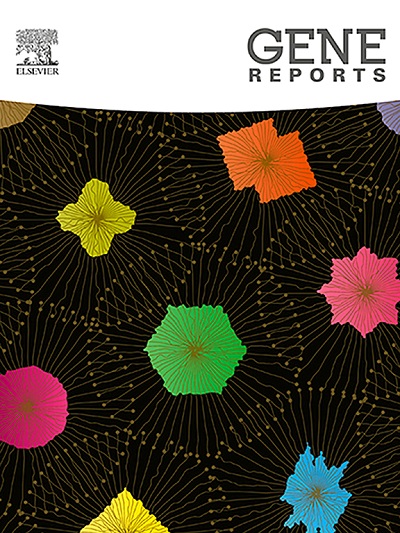In silico elucidation and network pharmacology analysis of phytochemicals from Elephantorrhiza elephantina and Pentanisia prunelloides for antitubercular activity
IF 1
Q4 GENETICS & HEREDITY
引用次数: 0
Abstract
Tuberculosis (TB), caused by Mycobacterium tuberculosis (Mtb), remains a global health challenge, exacerbated by drug-resistant strains. Phytochemicals, bioactive compounds from plants, offer a promising avenue for new drug development due to their diverse biological activities. This study focuses on two traditional medicinal plants, Elephantorrhiza elephantina and Pentanisia prunelloides, to identify potential anti-tuberculosis compounds. The compounds were initially evaluated for drug-likeness, followed by ADMET (absorption, distribution, metabolism, excretion, and toxicity) screening. Five compounds meeting these criteria were selected for further analysis. The 3D structures of these compounds were analyzed using PharmMapper to identify potential protein targets, focusing on those relevant to Mycobacterium tuberculosis. Protein-protein interaction networks were analyzed using STRING and Cytoscape to identify key hub genes. Additionally, KEGG pathway analysis was conducted with KOBAS to elucidate the biological processes, molecular functions, and cellular components involved. Homology modeling was performed using ITASSER to predict the 3D structure of target proteins. Finally, molecular docking studies were carried out to evaluate the binding interactions between the selected compounds and the MurF protein of Mycobacterium tuberculosis, followed by molecular dynamics simulations to assess the stability and conformational changes of the resulting protein-ligand complex over time. Among the compounds, arabinose (CID439195) demonstrated the strongest binding affinity to MurF, suggesting its potential as an anti-TB agent. These findings suggest that Elephantorrhiza elephantina and Pentanisia prunelloides hold significant potential for the development of new anti-tuberculosis therapies. This study underscores the importance of integrating computational approaches in drug discovery and highlights the promising role of phytochemicals in addressing global health challenges such as tuberculosis.

象鼻草和prunelloides植物化学物质抗结核活性的计算机解析和网络药理学分析
由结核分枝杆菌(Mtb)引起的结核病(TB)仍然是全球卫生挑战,耐药菌株加剧了这一挑战。植物化学物质是一类从植物中提取的生物活性化合物,因其具有丰富的生物活性,为新药开发提供了广阔的前景。本研究以两种传统药用植物象皮根(Elephantorrhiza elephantina)和prunelloides为研究对象,鉴定潜在的抗结核化合物。首先评估化合物的药物相似性,然后进行ADMET(吸收、分布、代谢、排泄和毒性)筛选。选择符合这些标准的5个化合物进行进一步分析。利用PharmMapper对这些化合物的三维结构进行分析,以确定潜在的蛋白靶点,重点关注与结核分枝杆菌相关的蛋白靶点。利用STRING和Cytoscape分析蛋白-蛋白相互作用网络,鉴定关键枢纽基因。此外,利用KOBAS进行KEGG通路分析,以阐明所涉及的生物过程、分子功能和细胞成分。利用ITASSER进行同源性建模,预测目标蛋白的三维结构。最后,进行分子对接研究,评估所选化合物与结核分枝杆菌MurF蛋白之间的结合相互作用,随后进行分子动力学模拟,评估所得到的蛋白质-配体复合物的稳定性和随时间的构象变化。在这些化合物中,阿拉伯糖(CID439195)与MurF的结合亲和力最强,表明其作为抗结核药物的潜力。这些研究结果表明,象皮菌和prunelloides Pentanisia在开发新的抗结核疗法方面具有重要的潜力。这项研究强调了在药物发现中整合计算方法的重要性,并强调了植物化学物质在应对结核病等全球健康挑战方面的有希望的作用。
本文章由计算机程序翻译,如有差异,请以英文原文为准。
求助全文
约1分钟内获得全文
求助全文
来源期刊

Gene Reports
Biochemistry, Genetics and Molecular Biology-Genetics
CiteScore
3.30
自引率
7.70%
发文量
246
审稿时长
49 days
期刊介绍:
Gene Reports publishes papers that focus on the regulation, expression, function and evolution of genes in all biological contexts, including all prokaryotic and eukaryotic organisms, as well as viruses. Gene Reports strives to be a very diverse journal and topics in all fields will be considered for publication. Although not limited to the following, some general topics include: DNA Organization, Replication & Evolution -Focus on genomic DNA (chromosomal organization, comparative genomics, DNA replication, DNA repair, mobile DNA, mitochondrial DNA, chloroplast DNA). Expression & Function - Focus on functional RNAs (microRNAs, tRNAs, rRNAs, mRNA splicing, alternative polyadenylation) Regulation - Focus on processes that mediate gene-read out (epigenetics, chromatin, histone code, transcription, translation, protein degradation). Cell Signaling - Focus on mechanisms that control information flow into the nucleus to control gene expression (kinase and phosphatase pathways controlled by extra-cellular ligands, Wnt, Notch, TGFbeta/BMPs, FGFs, IGFs etc.) Profiling of gene expression and genetic variation - Focus on high throughput approaches (e.g., DeepSeq, ChIP-Seq, Affymetrix microarrays, proteomics) that define gene regulatory circuitry, molecular pathways and protein/protein networks. Genetics - Focus on development in model organisms (e.g., mouse, frog, fruit fly, worm), human genetic variation, population genetics, as well as agricultural and veterinary genetics. Molecular Pathology & Regenerative Medicine - Focus on the deregulation of molecular processes in human diseases and mechanisms supporting regeneration of tissues through pluripotent or multipotent stem cells.
 求助内容:
求助内容: 应助结果提醒方式:
应助结果提醒方式:


